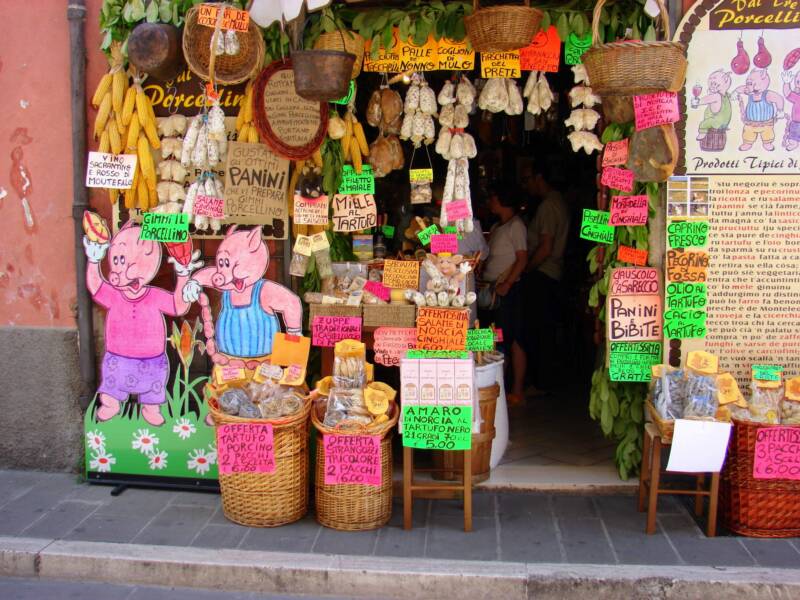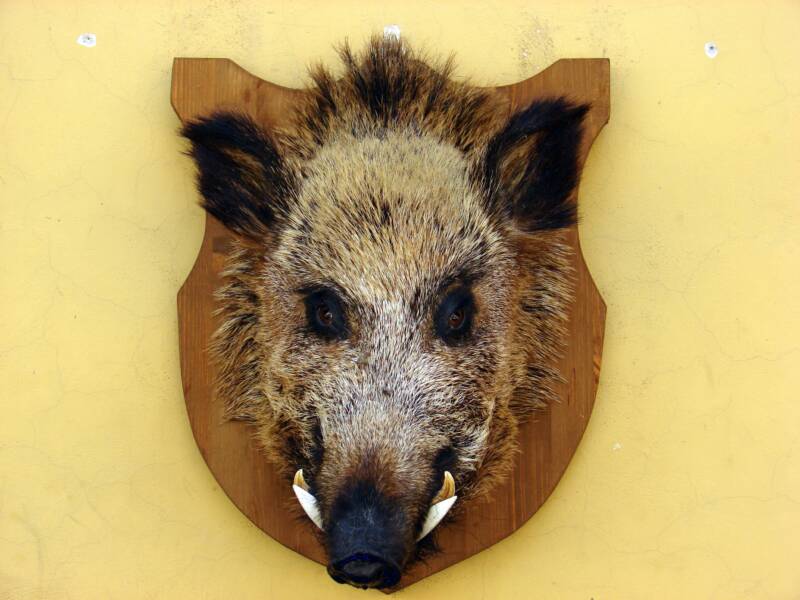Abundance
We rose early on a Saturday in October
and set off in the morning mists to find
the Archeologia Arborea, a local farm
devoted to the conservation of rare and
forgotten fruit trees.
There are no grand signs to lead you in...
you can't find it on google maps or with a
gps. This rustic farmhouse with its
sprawling orchard is tucked back up a
long gravel drive in the hills of northern
Umbria. The road is rutted and
unmanicured with thistle and wild grasses
blowsing along the verge. By the look of it,
you'd believe you were bumping along an old farm track or a fire road. Then suddenly, you arrive, without fanfare... no sign other than vineyards and fruit trees.
We are greeted by a large, snuffling hound dog then a shouted "buon giorno" from Isabella dalla Ragione, the proprietress. It is a warm, sunny day so we leave our coats in the car and set off on a tour of the property with Isabella. The farm house and adjacent old chapel are situated at the top of the hill. We begin our tour here with the vineyards where local grape species like biancone (big white one) and uva delle vecchie (grapes of the old ones) are grown. Several species of peach tree have been planted up here next to the vines. The rocky soil holds the heat, limiting the risk of frost damage to tender peach buds. Several scarecrows leaned jauntily at the edges of the rows, overstuffed and faded by the sun. Below us, the hill has been terraced and the fruit trees wind along the terraces and spill down the hillside. Rustic fences made of saplings line the terraced orchard, providing the occasional grip for human hand or wild tendrils.
The dalla Ragione's began this project some 25 years ago, when Isabella's father bought the land and the buildings, then began searching abandoned farms, parish gardens and monastery orchards for forgotten trees. He brought back cuttings and seeds to replant and nurture here in the arborea. The orchard grew over time, as the family added newly discovered species. Today there are over 100 acres with more than 500 trees and vines. Isabella's living museum includes more than 46 species of apple, 25 species of pear, and a plethora of plums, peaches, cherries and nut trees. The Arborea includes more unfamiliar species like mela cotogne (quince), sorbus (rowan), nespole (loquat or medlar), and guiggiole (jujube). As we walked the terraces, Isabella pointed out the names of these old species and talked about where they were from, what they were known for. Here was a frost resistant apple, there a late-setting cherry. These genetic differences were important to old farmers who knew their land and its idiosyncracies. If you lived in the valley along the creek, where the sun hits later in the day and the moisture in the air makes heavy frost a distinct possibility, planting frost resistant trees or trees that set their flowers late made a world of difference in your success at harvest. Knowing which trees posses which strengths and weaknesses was the job of the farmer. But as farmers age and children move away in search of work away from the family farm, that old knowledge is not passed along. Worldwide, we are losing fruit and vegetable species at an alarming rate. As elders die, their knowledge and their seed stores die with them. As a people, we lose pieces of our cultural heritage and food traditions.
To help get their story out and raise awareness, the Archeologia Arborea allows patrons to adopt trees. Adoption lasts for the lifetime of the tree and confers on the adopter (or tutor) the right to harvest the fruits of the adopted tree each year. The Arborea requests that three fruits be left on the tree - one for the sun, one for the earth and one for the tree - in accordance with old traditions. Each adopted tree is accompanied by a rough wooden sign bearing the tutor's name and where they live. There were names from all over Italy and the rest of the world. Each has the pleasure of knowing they are keeping a vanishing species alive. There is something enchanting about adopting an heirloom fruit... a species particular to a small place in this big world.
What will we have left when the supermarkets only offer Red Delicious and Granny Smith?
We wound back up from the orchard, excited about the limoncella apple and the pera di burro. Isabella brought us to the old chapel where long wooden tables were covered with baskets of fruit - rosy striped apples, huge yellow quince and bright green pears. A single layer of golden walnuts lay in a shallow basket drying. At the end of the longish room is teh old altar, now laden with a collection of old wooden crosses in blues, silver and gold. The effect is somewhat pagan... a sacred place filled with offerings to the goddess.
"Vuoi un cafe?" Isabella invited us into the farmhouse for coffee and cake. The farmhouse was a treasure trove of well worn household implements, faded pottery and signs of the old farm life. The kitchen fireplace was large enough to stand in, with a hewn chestnut mantle adorned with rusty keys, old tools and colorful treasures hung from large nails along its length. An ancient andiron that once cupped pitchers in the warmth of the hearth now held pairs of garden gloves drying by the fire. The beams above us were draped with golden and amber grapes drying slowly, waiting for the making of vin santo. Isabella made coffee in a stove-top espresso maker, pouring it into brightly colored espresso cups. We moved to the main room, a veritable museum of collected art and oddities: A series of teacups hanging from the mantle, a tray of bright pitchers and an ancient glass funnel sitting by the mirror. bright red rose hips arching elegantly from a vase added fire to the room. The long wooden table had a patina that could only come through years of use, the gloss of hands and elbows acquired over generations. We sat by a long wooden platter of autumn fruits eating a rich, chocolate almond torte and sipping espresso while Isabella talked about her book project, Arboreal Archeology: A Diary of Two Fruit Explorers. We thumbed through as she spoke, devouring each page, a picture of a fruit from their orchard juxtaposed with a frescoe or painting of the fruit. Apples to apples, figs to figs. I found myself dreaming of working on the hill at the end of a long dusty road, pruning fruit trees, preparing cakes for guests, and leading tours to tell people about the history and the fruits of our labors.
Please visit The Archeologia Arborea online for more information about the organization or the adoption of heirloom fruit trees.


